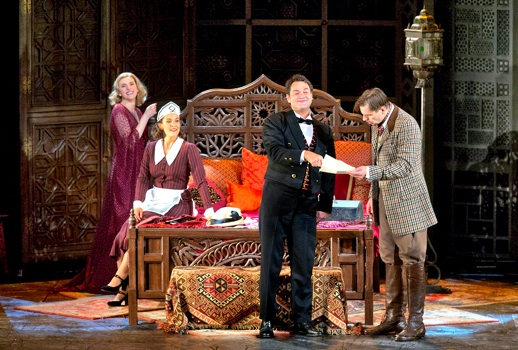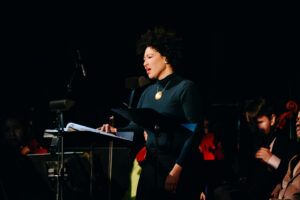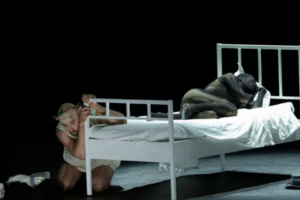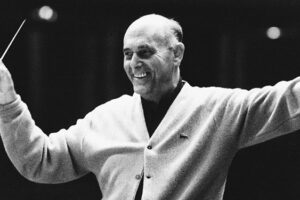

Eyre updated the production to the 1930’s, so out went the frills and corsets, and in came practical if dowdy mid-calf dresses that allowed for quick costume changes. Sometimes the singers were in such a hurry to make their exits that they completely forget to use the “doors” in the set and instead walked straight across the apron of the stage.
The direction is pretty traditional Figaro fare. There’s no new concept imposed on the work. It’s a no fuss, no muss production. It will probably serve the house well in a gazillion revivals. However for a new production it already feels stale and routine, and for this the blame can be laid probably less on Eyre than on conductor James Levine.
The maestro seems to have divided the entire score into “the important stuff” and “the other stuff.” When Jimmy feels that a moment is “important,” slows the orchestra down to a deliberate crawl, and severely tests the breath control of all his singers. This is probably to highlight the “beautiful” parts of the score, but the end result is bizarre.
For instance the breathless, fervent “Non so piú” became a dirge where poor Isabel Leonard (Cherubino) at one point was singing completely a cappella and kept looking nervously down at the orchestra to see when Jimmy would pick his baton up again. When Jimmy deems the music “not important” he barnstorms through it with all the sensitivity you might expect from a 1950’s Parma Tosca air check. The wonderful contrasts and nuances of Mozart’s score were erased.
The good thing about a premiere production is there was some effort to cast even the minor roles with quality singers. Ying Fang (Barbarina) was exquisite, with a beautiful bell-like voice and a naturally sweet stage face. “L’ho perduta, me meschina” was oddly the one time where Jimmy’s “let time stand still” approach worked—with a voice like Fang’s, you wanted the little aria to last forever. It was wonderful to see Suzanne Mentzer (Marcellina) again—she’s still a beautiful woman and a natural in Mozart. I didn’t really like John del Carlo’s blustery Bartolo but he’s a good comic actor and he and Mentzer made a nice comic team.
The leads were less evenly matched. Let’s start with the good: Peter Mattei (Count Almaviva) was amazing. His voice is large and naturally silky (my most vivid memory of him is how he made Amfortas’s often excruciatingly long monologues into ethereal mad scenes), but his singing was Exhibit A in how Mozart does not equal boring vocalise.
He brought an energy and menace (as well as a certain Donald Trump-like buffoonery) to everything he sang. His double aria in Act Three was a master class in how to make the Count simultaneously loathsome and sexy. Mattei was the only lead to make his character a three-dimensional person. You recognize this guy, and you’d avoid getting into an elevator with him.
Also excellent was Leonard as Cherubino. The 1930’s costume made her look like K.D. Lang, but she made for a sympathetic, fun, funny pageboy. I’ve often found Leonard pretty but bland in the past, but she was a real charmer tonight and “Voi che sapete” was lovely, despite Levine’s bizarre ritards during the aria.
Ildar Abdrazakov (Figaro) was cruder, and often played the role for cheap laughs, but his voice is basically pleasing and he looks nice in a suit. He wasn’t helped by the fact that Levine deemed his arias “unimportant” and stormed through them without a hint of subtlety. For instance the sarcastic, mocking tone of “Non piú andrai” was gone with Jimmy shooing him through the music.
Which leads me to the two women. The Contessa and Susanna are really the heart of the opera. If you don’t care about them, there’s no real reason to watch. Marlis Petersen is an excellent singer who is miscast as Susanna. For one, her tall and somewhat mature persona seem odd in a role that calls for, well, cuteness. Her voice is amazing in the upper extremes (she sings Ophélie and Lulu), but somewhat colorless and cold in the middle, and most of Susanna’s music lies exactly in that uninteresting tessitura. “Deh vieni non tardar” had her dipping into a non-existent lower register. But, since she’s basically a smart singer, she was able to make the performance professional, if not endearing.
Amanda Majeski (Contessa) was way more problematic. She looks like a Countess—tall and majestic looking, like a Hitchcock heroine in her blond perm. But from the opening of “Porgi amor” there was a nervous, unsteady vibrato that intruded into every note she sang. It’s not a controlled fast vibrato of the Ezio Pinza/Conchita Supervia tradition. Instead she sounded like she had Parkinson’s disease in her voice box. Her high notes were wiry and even more unsteady. Her face looked frozen with nervousness. I so wanted to like her, as I always root for those last minute replacements, but Majeski’s voice is just unlikable.
Susanna and Contessa’s interactions can be played a variety of ways. They can be like upstairs/downstairs sisters, or there can be a more formal, warm employer/employee vibe. But there has to be a rapport between them—the entire opera rests on the idea that these two women, who might be natural rivals, instead hatch a clever plot because of their mutual trust and friendship.
Majeski and Petersen, though, had anti-chemistry. Even the final hug between the two women looked forced, what I call an “ice hug” where one person lightly puts her arms around the other person’s shoulders while avoiding any other point of contact. They didn’t look like women who live together and are familiar with each other. They looked like two sopranos assigned to be onstage together at the same time. The blend in their voices was awful—Majeski’s nervous, wiry soprano completely out of sync with Petersen’s cool, slender instrument. This was most apparent in “Sull’aria” but none of their scenes together were remotely enjoyable.
It remains to be seen whether new casts and perhaps a rethinking will warm up this Figaro. Right now the handsomely lavish sets but chilly vibe reminds me more of Manon Lescaut’s lament “In quelle trine morbide, nell’alcova dorata v’è un silenzio…”
This was the first performance I won through the new rush ticket lottery program. In the past if you were doggedly determined (or, in my case, unemployed) you could stand in the Met downstairs garage and queue for tickets. This online lottery system I suspect was intended to do two things: to coax people to buy full-price tickets for things they really wanted to see (for instance, I bought a ticket for Macbeth), but also to drum up attendance for items that were not selling well. I mean, if you win a $25 orchestra seat, why not get your butt to the Met and check it out? It’s a less predictable system but certainly easier than waiting for hours in the garage.
Also spotted in the audience: a very glam Angela Gheorghiu, blowing kisses and waving down the orchestra aisle. Presumably she didn’t have to enter the lottery.
Photo: Ken Howard/Metropolitan Opera

























Comments